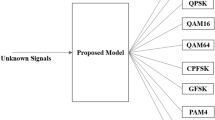Abstract
Automatic modulation classification plays an important role in many fields to identify the modulation type of wireless signals in order to recover signals by demodulation. In this paper, we contribute to explore the suitable architecture of deep learning method in the domain of communication signal recognition. Based on architecture analysis of the convolutional neural network, we used real signal data generated by instrument as dataset, and achieved compatible recognition accuracy of modulation classification compared with several representative structure. We state that the deeper network architecture is not suitable for the signal recognition due to its different characteristic. In addition, we also discuss the difficult of training algorithm in deep learning methods and employ the transfer learning method in order to reap the benefits, which stabilize the training process and lift the performance. Finally, we adopt the denoising autoencoder to preprocess the received data and provide the ability to resist finite perturbations of the input. It contributes to a higher recognition accuracy and it also provide a new idea to design the denoising modulation recognition model.














Similar content being viewed by others
Explore related subjects
Discover the latest articles and news from researchers in related subjects, suggested using machine learning.References
Alain, G., & Bengio, Y. (2014). What regularized auto-encoders learn from the data generating distribution. Journal of Machine Learning Research, 15(1), 3563–3593.
Bengio, Y., Simard, P., & Frasconi, P. (1994). Learning long-term dependencies with gradient descent is difficult. IEEE Transactions on Neural Networks, 5(2), 157–166.
Bourlard, H., & Kamp, Y. (1988). Auto-association by multilayer perceptrons and singular value decomposition. Biological Cybernetics, 59(4–5), 291.
Glorot, X., & Bengio, Y. (2010). Understanding the difficulty of training deep feedforward neural networks. Journal of Machine Learning Research, 9, 249–256.
Hazza, A., Shoaib, M., Alshebeili, S.A., & Fahad, A. (2013). An overview of feature-based methods for digital modulation classification. In: 1st International conference on communications, signal processing, and their applications (ICCSPA) (pp. 1–6).
He, K., Zhang, X., Ren, S., & Sun, J. (2016). Deep residual learning for image recognition. In: IEEE conference on computer vision and pattern recognition (CVPR) (pp. 770–778)
He, K., Zhang, X., Ren, S., & Sun, J. (2016). Identity mappings in deep residual networks. In European conference on computer vision (pp. 630–645).
Hinton, G. E., Srivastava, N., Krizhevsky, A., Sutskever, I., & Salakhutdinov, R. R. (2012). Improving neural networks by preventing co-adaptation of feature detectors. Computer Science, 3(4), 212–223.
Hinton, G. E., & Zemel, R. S. (1993). Autoencoders, minimum description length and helmholtz free energy. In International conference on neural information processing systems (pp. 3–10).
Hyvrinen, A., Hurri, J., & Hoyer, P. O. (2005). Estimation of non-normalized statistical models. Journal of Machine Learning Research, 6(4), 695–709.
Krizhevsky, A., Sutskever, I., & Hinton, G. E. (2012). Imagenet classification with deep convolutional neural networks. Communications of the ACM, 60(2), 2012.
LeCun, Y., Boser, B., Denker, J. S., Henderson, D., Howard, R. E., Hubbard, W., et al. (1989). Backpropagation applied to handwritten zip code recognition. Neural Computation, 1(4), 541–551.
Nair, V., & Hinton, G. E. (2010). Rectified linear units improve restricted boltzmann machines. In International conference on international conference on machine learning (pp. 807–814).
OShea, T. J., Corgan, J., & Clancy, T. C. (2016). Convolutional radio modulation recognition networks. In International conference on engineering applications of neural networks (pp. 213–226).
Pan, S. J., & Yang, Q. (2010). A survey on transfer learning. IEEE Transactions on Knowledge and Data Engineering, 22(10), 1345–1359.
Polyak, B. T. (1964). Some methods of speeding up the convergence of iteration methods. USSR Computational Mathematics & Mathematical Physics, 4(5), 791–803.
Rifai, S., Vincent, P., Muller, X., Glorot, X., & Bengio, Y. (2011). Contractive auto-encoders: Explicit invariance during feature extraction. In Proceedings of the 28th international conference on machine learning, ICML 2011 (pp. 833–840)
Tang, Y., & Eliasmith, C. (2010). Deep networks for robust visual recognition. In International conference on machine learning (pp. 1055–1062).
Vincent, P., Larochelle, H., Bengio, Y., & Manzagol, P. A. (2008). Extracting and composing robust features with denoising autoencoders. In International conference on machine learning (pp. 1096–1103).
West, N. E., & O’Shea, T. (2017). Deep architectures for modulation recognition. In: IEEE international symposium on dynamic spectrum access networks (DySPAN) (pp. 1–6).
Yazan, E., & Talu, M. F. (2017). Comparison of the stochastic gradient descent based optimization techniques. In International artificial intelligence and data processing symposium (IDAP) (pp. 1–5)
Zhu, X., & Fujii, T. (2017). A modulation classification method in cognitive radios system using stacked denoising sparse autoencoder. In IEEE Radio and Wireless Symposium (RWS) (pp. 218–220)
Acknowledgements
This work was supported by National Natural Science Foundation of China (Nos. 61601147, 61571316). Fundamental Research Funds of Shenzhen Innovation of Science and Technology Committee (JCYJ20160331141634788), and the Fundamental Research Funds for the Central Universities (Grant No. HIT. MKSTISP. 2016013).
Author information
Authors and Affiliations
Corresponding author
Rights and permissions
About this article
Cite this article
Xu, Y., Li, D., Wang, Z. et al. A deep learning method based on convolutional neural network for automatic modulation classification of wireless signals. Wireless Netw 25, 3735–3746 (2019). https://doi.org/10.1007/s11276-018-1667-6
Published:
Issue Date:
DOI: https://doi.org/10.1007/s11276-018-1667-6




